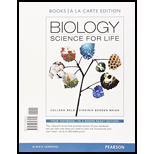
Concept explainers
To analyze:
The structure of a virus and a bacterium.
Introduction:
The bacteria are the prokaryotic organism, which is living and posses all the characteristics of the cells. The viruses are the infectious agents, having
Explanation of Solution
The structure of a typical bacterium lacks a nucleus and membrane-bound organelles, that is why they are classified as prokaryotes. The outer layer of the bacteria is referred to as a capsule, which is the protective layer. The capsule surrounds the cell envelope of the bacteria. They have their genetic material located at a particular region in the cytoplasm known as the nucleoid. The ribosome of 70S type is also present in the cytoplasm. On the outer surface, flagella and pili are found. The flagella are a hair-like structure that helps in locomotion. The pili help the bacteria in adhesion to the surface.
All viruses have a nucleic acid genome, either DNA or RNA. A protein capsid is a protein covering around the genome of a virus. It forms nucleo-capsid together with the nucleic acid genome. It is formed of several oligomeric structural subunits that are known as protomers. The sheath is an external covering like structure that wraps the protruding tail fibers. Tail fiber is a tail-like structure that acts as a chemical sensor for the virus to identify the receptors present on the surface of the host cell. End plate helps in the attachment of the virus to the host cell.
The bacterium is a prokaryotic cell having a cell wall, cytoplasm, ribosome, and the nucleoid. The virus is made up of head and tail region, with genetic material present in the head region inside a protein capsid. The tail region has an end plate, which is the
Want to see more full solutions like this?
Chapter 20 Solutions
Biology: Science For Life, Books A La Carte Plus Mastering Biology With Etext -- Access Card Package (5th Edition)
 Human Anatomy & Physiology (11th Edition)BiologyISBN:9780134580999Author:Elaine N. Marieb, Katja N. HoehnPublisher:PEARSON
Human Anatomy & Physiology (11th Edition)BiologyISBN:9780134580999Author:Elaine N. Marieb, Katja N. HoehnPublisher:PEARSON Biology 2eBiologyISBN:9781947172517Author:Matthew Douglas, Jung Choi, Mary Ann ClarkPublisher:OpenStax
Biology 2eBiologyISBN:9781947172517Author:Matthew Douglas, Jung Choi, Mary Ann ClarkPublisher:OpenStax Anatomy & PhysiologyBiologyISBN:9781259398629Author:McKinley, Michael P., O'loughlin, Valerie Dean, Bidle, Theresa StouterPublisher:Mcgraw Hill Education,
Anatomy & PhysiologyBiologyISBN:9781259398629Author:McKinley, Michael P., O'loughlin, Valerie Dean, Bidle, Theresa StouterPublisher:Mcgraw Hill Education, Molecular Biology of the Cell (Sixth Edition)BiologyISBN:9780815344322Author:Bruce Alberts, Alexander D. Johnson, Julian Lewis, David Morgan, Martin Raff, Keith Roberts, Peter WalterPublisher:W. W. Norton & Company
Molecular Biology of the Cell (Sixth Edition)BiologyISBN:9780815344322Author:Bruce Alberts, Alexander D. Johnson, Julian Lewis, David Morgan, Martin Raff, Keith Roberts, Peter WalterPublisher:W. W. Norton & Company Laboratory Manual For Human Anatomy & PhysiologyBiologyISBN:9781260159363Author:Martin, Terry R., Prentice-craver, CynthiaPublisher:McGraw-Hill Publishing Co.
Laboratory Manual For Human Anatomy & PhysiologyBiologyISBN:9781260159363Author:Martin, Terry R., Prentice-craver, CynthiaPublisher:McGraw-Hill Publishing Co. Inquiry Into Life (16th Edition)BiologyISBN:9781260231700Author:Sylvia S. Mader, Michael WindelspechtPublisher:McGraw Hill Education
Inquiry Into Life (16th Edition)BiologyISBN:9781260231700Author:Sylvia S. Mader, Michael WindelspechtPublisher:McGraw Hill Education





